|
|
|
Sort Order |
|
|
|
Items / Page
|
|
|
|
|
|
|
| Srl | Item |
| 1 |
ID:
123594
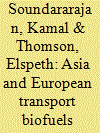

|
|
|
|
|
| Publication |
2013.
|
| Summary/Abstract |
Over the past decade, both Asia and Europe have devoted considerable effort to expanding the production of first-generation biofuels to fuel cars, taxis, buses, trucks, motorcycles, etc. On the one hand, with "peak oil" potentially looming in the future, and on the other, with an insatiable need for petroleum and diesel, the prospect of large-scale use of biofuels enjoyed tremendous public appeal as they seemed to provide a long-term alternative and clean fuel source in Asia and Europe. However, globally today, biofuels constitute only 3 % of the total transport fuel mix. Production is still steadily increasing in some countries, but their economic competitiveness and environmental sustainability have come into question in others with the result that production has slowed down considerably or even halted. The outlook for second- and third-generation biofuels is promising. However, they also cannot yet supplement, far less substitute, for petroleum and diesel in a commercially viable way.
|
|
|
|
|
|
|
|
|
|
|
|
|
|
|
|
| 2 |
ID:
123591


|
|
|
|
|
| Publication |
2013.
|
| Summary/Abstract |
We bring together a collection of papers that were presented at the inaugural event of the Asia-Europe Energy Policy Research Network (AEEPRN), held at Singapore in May 2012. The idea for creating AEEPRN was in response to the growing importance of energy in Asia and Europe's relations and to our shared belief that energy will become a more significant aspect of these relations over the forthcoming years and decades. The papers presented here cover the following themes: wind energy, biofuels, natural gas and gas pipelines, exergy and manufacturing, green energy co-operation, coal, unconventional gas and solar energy.
|
|
|
|
|
|
|
|
|
|
|
|
|
|
|
|
| 3 |
ID:
123596
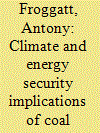

|
|
|
|
|
| Publication |
2013.
|
| Summary/Abstract |
The importance of the coal sector is often overlooked by the media when reviewing global energy. This is despite both its importance in many emerging economies and its impact on climate change. The current status and projections for coal use in Asia and Europe vary considerably. In Asia, growth in demand and availability of coal is resulting in its accelerated use. However, despite investment, production cannot keep up with demand, and coal trade in Asia is increasingly affecting international markets. In Europe, the environmental impacts of coal use, particularly CO2 but also particulates, are accelerating the closure of many power stations and delaying new build. Consequently, in most countries its contribution is set to decrease. However, some countries are planning new, large coal stations and are increasing operation prior to closure of some existing stations. The continued use of fossil fuels, especially coal, is resulting in emission levels that in the short term will exceed the internationally agreed climate protection objectives. Therefore, Europe and Asia need to accelerate their co-operation in developing carbon capture and storage and other new technologies and policies in order to minimise the emissions to the greatest extent possible.
|
|
|
|
|
|
|
|
|
|
|
|
|
|
|
|
| 4 |
ID:
123595
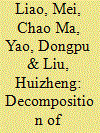

|
|
|
|
|
| Publication |
2013.
|
| Summary/Abstract |
This article uses the concept of embodied exergy as metrics in designing incentive policy instruments to tackle the inefficiency of energy operations. Based on the second law of thermodynamics and energy's economic properties as both a private commodity and a public good, it maintains that energy can be measured by separating the useful exergy embodied in a manufactured product from its waste exergy (anergy) as emissions and sunk wastes in a production process. It is rational to benchmark the content of useful exergy embodied in products for any incentive policy design to encourage green production. This article uses trade data between China, Japan and the EU countries to compare the embodied exergy and waste exergy embodied in traded manufactured products. It proposes using a negative value-added tax as an incentive instrument instead of full-scale carbon tariffs to encourage green production and to fence against carbon evasion behaviour.
|
|
|
|
|
|
|
|
|
|
|
|
|
|
|
|
| 5 |
ID:
123598
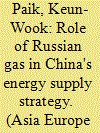

|
|
|
|
|
| Publication |
2013.
|
| Summary/Abstract |
China's gas industry has witnessed a massive expansion and Chinese energy planners envisage a huge development of natural gas in China until 2030. This growth requires large-scale imports of gas in the coming two decades. This article discusses the role of Russian gas exports in China's gas expansion. It analyses China's natural gas growth in the coming decades, based on the projections of China's domestic production capacity and the consequent necessity of large-scale pipeline gas imports from Russia, the Central Asian Republics, and Myanmar. Included in the projections are LNG imports from Southeast Asia, the Middle East, Australia, North America, and East Africa. The article explains how Russia is trying to avoid depending exclusively on the China market by using the options of gas exports to Korea and Japan. However, it concludes that Russia's pipeline gas exports to China will play an important role in China's energy supply plan in the coming decades.
|
|
|
|
|
|
|
|
|
|
|
|
|
|
|
|
| 6 |
ID:
123599


|
|
|
|
|
| Publication |
2013.
|
| Summary/Abstract |
This article examines and compares the design and roll-out of solar policies of three major markets in Asia and Europe in 2012. The photovoltaic ("PV") and concentrated solar power ("CSP") policies of India, Thailand, Malaysia, in Asia and Germany, Italy and Spain in Europe are analysed on the basis of policy documents publicly available on web portals of the relevant government authorities in the respective countries in addition to independent reports and studies. The aim here is to measure and compare the form and quantum of state support extended to the solar power generation sector in these six fairly comparable countries in Asia and Europe, provide an overview of the design and deployment of solar power policies and estimate the costs of carbon mitigation through solar power in the six countries. The countries were chosen on the basis of available information and data in English from primary sources such as government policy documents, announcements and reports, and the scale of solar power policies and their relative maturity.
|
|
|
|
|
|
|
|
|
|
|
|
|
|
|
|
| 7 |
ID:
123593
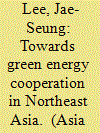

|
|
|
|
|
| Publication |
2013.
|
| Summary/Abstract |
Faced with the dual challenge of depletion of fossil fuels and climate change, three Northeast Asian countries-China, Japan and Korea-introduced green energy initiatives in recent years. Even though the portion of renewable energy in the energy mix has been limited, a rapid shift to green initiatives has given a strong boost to renewable energy resources. Cooperation with respect to green energy in Northeast Asia (NEA) may eventually overcome the geopolitical constraints and zero-sum nature of the fossil fuel supply in the region. However, this cooperation also faces a number of obstacles to be overcome. Energy cooperation in NEA is still in an embryonic stage, and the level of institutionalisation is low. Green energy cooperation is not free from neo-mercantilist competition either, as the current green initiatives entail elements of strong industrial policy. European experience may shed light on the burgeoning green energy cooperation in NEA, in terms of methods and scope. The EU is currently adopting the most advanced policies on renewable energy and climate change. A series of green energy initiatives has provided a concrete platform for further green energy cooperation that could be pursued at the Union level. On the other hand, the history of European energy cooperation indicates that a long stage of market integration, institutional development and policy coordination are prerequisite. Northeast Asian green energy cooperation should be based on a continued momentum of green initiatives at the domestic level as well as the advancement of sub-regional institutional build-up. Regional multilateral institutions, such as Asia-Pacific Economic Cooperation, Association of Southeast Asian Nations Plus Three and ASEAN Regional Forum, as well as diverse international organisations and Track II institutions can provide a useful venue for Northeast Asian countries to share information and adopt a common position towards green energy cooperation.
|
|
|
|
|
|
|
|
|
|
|
|
|
|
|
|
| 8 |
ID:
123597
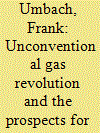

|
|
|
|
|
| Publication |
2013.
|
| Summary/Abstract |
The development of unconventional gas exploration in the USA, in particular shale gas, caused a revolution in the American and the global gas markets. The regional-wide use of unconventional gas resources could stabilise the natural gas demand and the energy supply security of European and Asian countries. But traditionally, almost all gas contracts in Europe and Asia are linked to oil because of the demand for stable, long-term contracts. Furthermore, in many Asian countries, large state-owned enterprises dominate their national gas markets, leading to little competition and incentives to reduce gas prices. In Europe, the expansion of unconventional gas is facing grassroots opposition from environmental groups who are concerned about ground water safety, adequate waste water management, seismic events and greenhouse gas emissions. This article examines the rapidly changing natural gas markets and the role and prospects of unconventional gas as well as the impacts it may have on European and Asian energy security. It highlights, in particular, the geo-economic and geo-political implications and discusses whether the US unconventional gas revolution can be duplicated in Europe and Asia.
|
|
|
|
|
|
|
|
|
|
|
|
|
|
|
|
| 9 |
ID:
123592
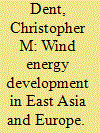

|
|
|
|
|
| Publication |
2013.
|
| Summary/Abstract |
Over the last decade, wind energy has emerged as the most important non-hydro renewables sector, contributing significantly to global efforts on developing low-carbon energy systems. In terms of grid electricity generation, its power output has increased almost 16-fold since 2000 and currently produces around 3 times that of solar photovoltaic, 4 times more than biomass and 20 times more than geothermal installations globally. Europe and East Asia have been at the forefront of wind energy development, together accounting for almost 70 % of total installed capacity and most of the world's largest wind turbine producers. This paper begins by providing an overview of historic and recent developments in wind energy and then discusses key techno-innovation, production and internationalisation issues before looking at policy approaches taken by European and East Asian countries to renewable energy generally and wind energy more specifically. Finally, obstacles to the future development of the wind energy sector are discussed.
|
|
|
|
|
|
|
|
|
|
|
|
|
|
|
|
|
|
|
|
|